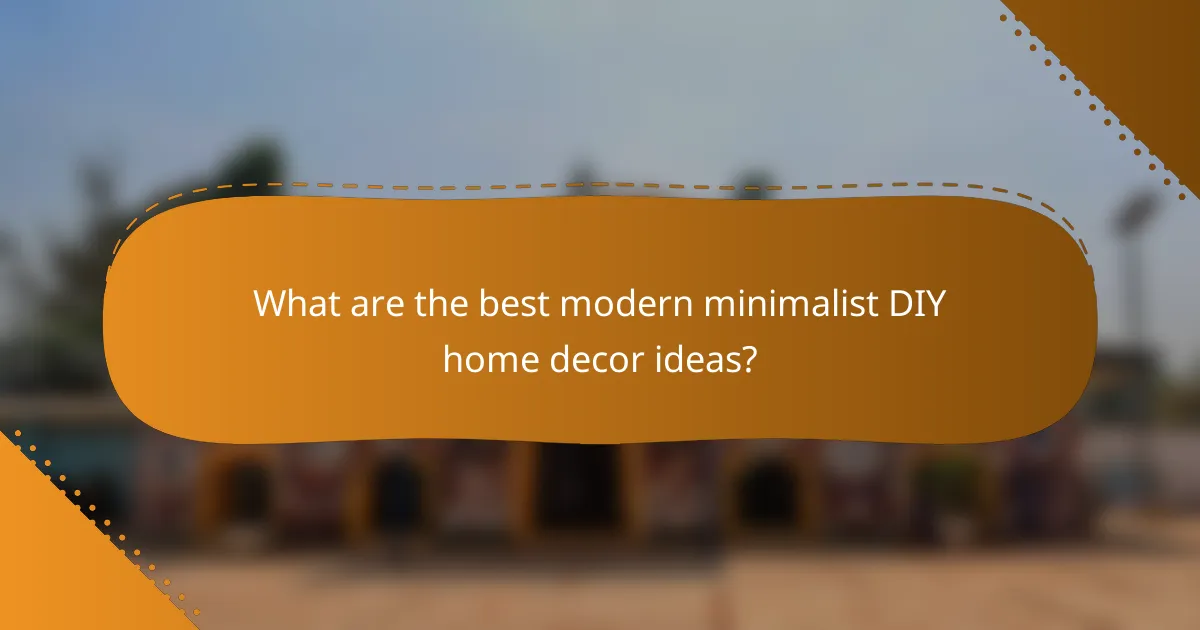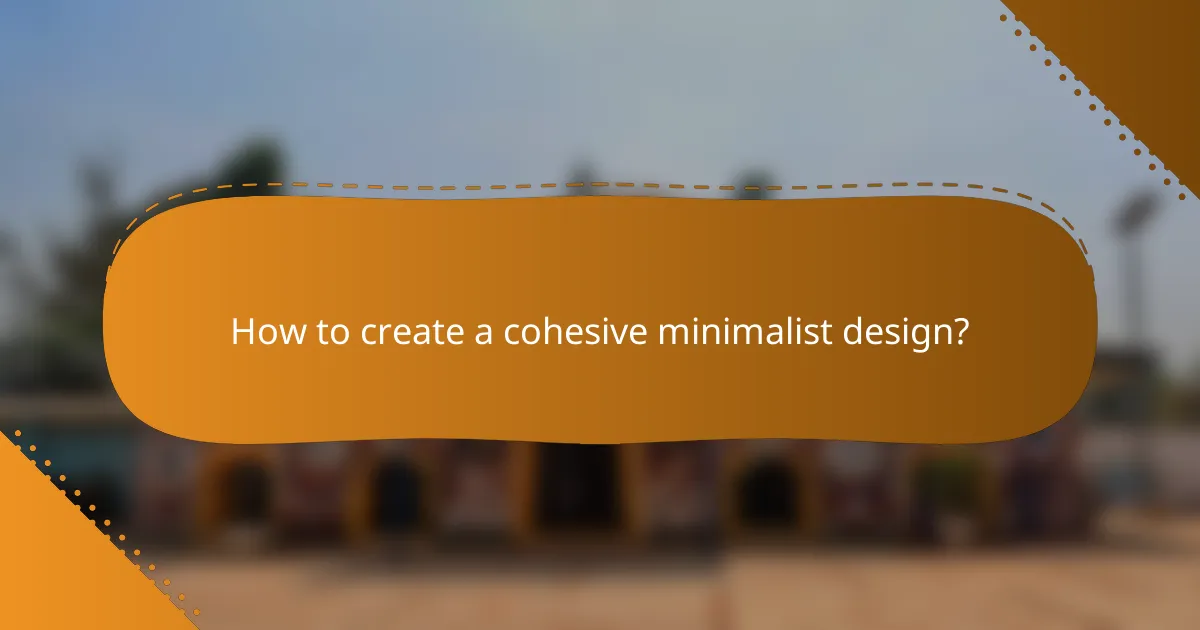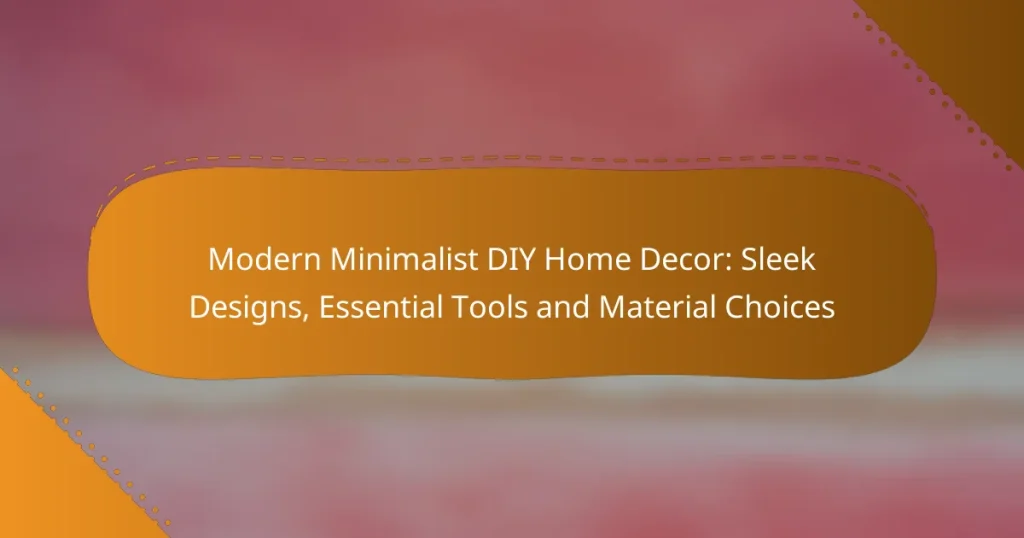Modern minimalist DIY home decor emphasizes simplicity, functionality, and clean lines, creating a serene environment that enhances your living space. By selecting essential tools tailored to your skill level and choosing materials like eco-friendly woods and sleek metals, you can achieve a stylish yet uncluttered aesthetic. This approach not only showcases your creativity but also aligns with the minimalist philosophy of focusing on what truly matters in your home.

What are the best modern minimalist DIY home decor ideas?
The best modern minimalist DIY home decor ideas focus on simplicity, functionality, and clean lines. Incorporating elements from various styles can enhance your space while maintaining a sleek aesthetic.
Scandinavian-inspired designs
Scandinavian-inspired designs emphasize light, airy spaces with a focus on functionality. Use neutral colors, natural light, and simple furniture to create a welcoming atmosphere. Consider adding wooden elements, such as a light oak table or birch shelving, to enhance the natural feel.
To achieve this look, opt for multi-functional furniture that maximizes space without cluttering. Accessories should be minimal; think of a few well-placed plants or simple wall art to maintain the aesthetic.
Industrial style accents
Industrial style accents bring a raw, urban edge to minimalist decor. Incorporate materials like metal, concrete, and reclaimed wood for a rugged yet refined look. Items such as metal light fixtures or a concrete coffee table can serve as striking focal points.
When using industrial elements, balance them with softer textures, like a plush rug or cozy throws, to avoid a harsh environment. This combination creates a welcoming space while retaining the minimalist ethos.
Japandi fusion aesthetics
Japandi fusion aesthetics blend Japanese and Scandinavian design principles, focusing on simplicity and natural materials. This style emphasizes craftsmanship and functionality, often featuring low-profile furniture and organic shapes. Consider using a low wooden table paired with simple, elegant seating.
To achieve this look, choose a muted color palette with earthy tones and incorporate elements like bamboo or rattan. This fusion creates a serene environment that promotes mindfulness and relaxation.
Monochromatic color schemes
Monochromatic color schemes involve using varying shades of a single color to create a cohesive look. This approach simplifies the visual experience and enhances the minimalist aesthetic. For instance, using different shades of gray can add depth while maintaining a clean appearance.
When implementing a monochromatic scheme, consider texture and material variation to keep the space interesting. Combine matte and glossy finishes, or mix fabrics like linen and wool to add dimension without overwhelming the design.
Natural materials integration
Integrating natural materials is essential for achieving a modern minimalist look. Materials like wood, stone, and cotton not only add warmth but also connect the indoors with nature. Use reclaimed wood for furniture or stone accents in decor to enhance the organic feel.
When selecting natural materials, prioritize sustainability and quality. Look for locally sourced options to reduce environmental impact and support local artisans. This approach not only beautifies your space but also promotes eco-friendly practices.

How to choose essential tools for DIY home decor?
Choosing essential tools for DIY home decor involves identifying the right equipment that matches your skill level and project needs. Beginners should focus on basic hand tools, while more experienced DIYers can invest in power tools for advanced projects.
Basic hand tools for beginners
Basic hand tools are crucial for any DIY home decor project, especially for beginners. Essential items include a hammer, screwdrivers, pliers, a utility knife, and a tape measure. These tools are versatile and can handle a wide range of tasks from assembling furniture to hanging artwork.
When selecting hand tools, consider quality over quantity. Investing in a few reliable tools will serve you better than a large set of low-quality items. Look for tools that feel comfortable in your hand and are easy to use.
Power tools for advanced projects
Power tools can significantly enhance your DIY capabilities, especially for larger or more complex projects. Common power tools include a cordless drill, circular saw, jigsaw, and sander. These tools allow for faster and more precise work compared to hand tools.
Before purchasing power tools, assess the types of projects you plan to undertake. For instance, a drill is essential for furniture assembly, while a jigsaw is great for cutting intricate shapes. Always prioritize safety by using protective gear and following the manufacturer’s instructions.
Measuring and leveling tools
Accurate measurements and level surfaces are vital in DIY home decor to ensure professional-looking results. Essential measuring tools include a tape measure, square, and caliper, while leveling tools like a spirit level or laser level help achieve straight lines and even surfaces.
When measuring, double-check your dimensions to avoid costly mistakes. For leveling, a laser level can be particularly helpful for larger spaces, as it projects a straight line across distances. Investing in these tools will improve the quality of your work and save time in the long run.

What materials are best for minimalist decor?
For minimalist decor, the best materials are those that emphasize simplicity and functionality while maintaining aesthetic appeal. Common choices include eco-friendly woods, sleek metals, and comfortable textiles that align with the minimalist philosophy of reducing clutter and focusing on essential elements.
Eco-friendly wood options
Eco-friendly wood options, such as bamboo, reclaimed wood, and certified hardwoods, are ideal for minimalist decor. Bamboo is particularly popular due to its rapid growth and sustainability, making it a responsible choice. Reclaimed wood adds character while minimizing environmental impact, and certified hardwoods ensure responsible sourcing.
When selecting wood, consider finishes that enhance the natural grain without overpowering the design. Light stains or natural oils can maintain a clean look while providing protection. Aim for a balance between durability and aesthetics to ensure longevity in your decor.
Metal finishes for a sleek look
Metal finishes, such as brushed nickel, stainless steel, and matte black, contribute to a sleek and modern minimalist aesthetic. These materials are not only durable but also versatile, easily integrating into various design schemes. The reflective quality of metals can enhance light and space, making rooms feel larger.
For furniture and fixtures, opt for simple shapes and clean lines to maintain the minimalist ethos. Avoid overly ornate designs; instead, focus on functionality and subtle elegance. Consider mixing different metal finishes for visual interest while keeping the overall palette cohesive.
Textiles for minimalist comfort
Textiles play a crucial role in adding comfort to minimalist decor without compromising simplicity. Natural fibers like cotton, linen, and wool are excellent choices, offering both comfort and breathability. Stick to a neutral color palette to maintain a clean and uncluttered look.
When selecting textiles, choose items that serve a dual purpose, such as throw blankets or cushions that provide warmth and texture. Avoid excessive patterns; instead, opt for solid colors or subtle textures to keep the focus on the overall design. Regularly declutter textiles to maintain a tidy space.

How to create a cohesive minimalist design?
Creating a cohesive minimalist design involves selecting a unified color palette, arranging furniture thoughtfully, and considering the impact of lighting. These elements work together to establish a serene and uncluttered environment that embodies the essence of minimalism.
Color palette selection
Choosing a color palette is crucial in minimalist design. Opt for neutral tones like whites, grays, and beiges, which can create a calm backdrop. You may incorporate one or two accent colors to add interest without overwhelming the space.
Consider using a limited range of colors, typically no more than three to five, to maintain harmony. For example, pairing soft whites with muted blues or greens can evoke tranquility while keeping the aesthetic clean.
Furniture arrangement principles
Effective furniture arrangement is key to achieving a minimalist look. Focus on functionality and flow; each piece should serve a purpose and allow for easy movement. Avoid overcrowding by selecting fewer, larger items rather than multiple small ones.
Position furniture to create open spaces and clear pathways. For instance, place a sofa against a wall with a simple coffee table in front, ensuring there is ample room to walk around. This arrangement promotes a sense of openness and simplicity.
Lighting considerations
Lighting plays a vital role in minimalist design, enhancing the overall atmosphere. Utilize natural light as much as possible by keeping windows unobstructed. Consider sheer curtains or blinds that allow light to filter in while maintaining privacy.
In addition to natural light, incorporate layered lighting with a mix of ambient, task, and accent lights. Use simple fixtures that align with the minimalist theme, such as pendant lights or recessed lighting, to maintain a sleek aesthetic.

What are the costs associated with DIY minimalist decor?
The costs of DIY minimalist decor can vary widely based on material choices, tools, and project scale. Generally, budgeting for this type of decor involves considering both initial investments and ongoing expenses for maintenance or replacements.
Budgeting for materials
When budgeting for materials, focus on essential items that align with minimalist principles, such as natural woods, neutral paints, and simple textiles. A typical budget might range from a few hundred to a couple of thousand dollars, depending on the size of the project and the quality of materials chosen.
Consider creating a detailed list of required materials and their estimated costs. This will help you avoid overspending and ensure you stick to your budget. Prioritize items that offer durability and timeless appeal to minimize future costs.
Cost-effective sourcing strategies
To keep costs down, explore various sourcing strategies. Local hardware stores, thrift shops, and online marketplaces can offer significant savings on materials. Look for sales, discounts, or clearance items that fit your design vision.
Another effective strategy is to repurpose or upcycle existing furniture and decor. This not only saves money but also adds a unique touch to your space. Joining local DIY groups or forums can provide insights on where to find affordable materials and share tips on budget-friendly projects.


